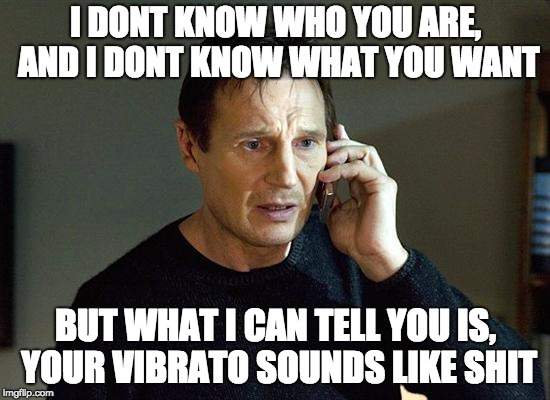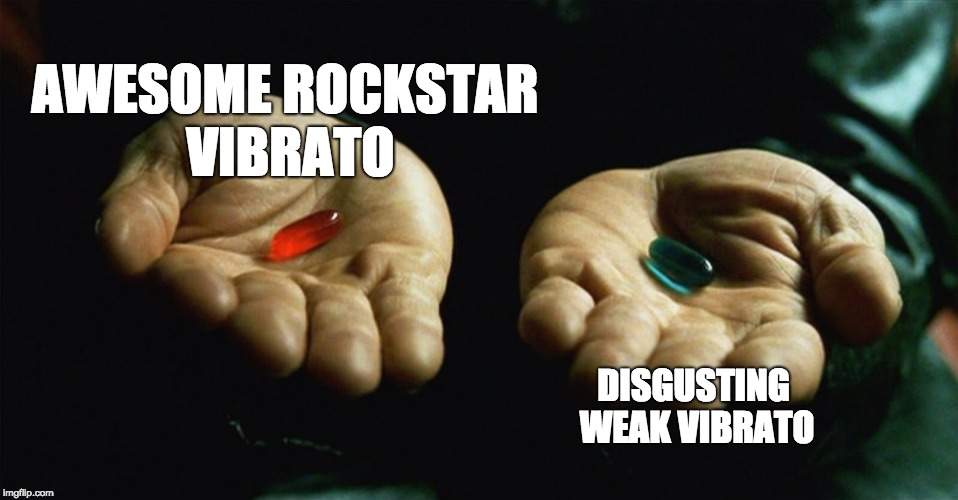Being a good musician starts and ends with being able to make one note sound awesome.
If you can’t make one note sound really great, then it doesn’t matter what else you can do — you’ve already lost the battle.
Before we go any further, know that I’m not one of these guys who thinks fast players have “no feel”. I love fast guitar players like Yngwie Malmsteen, Marty Friedman, Dimebag Darrell, Zakk Wylde, Steve Vai, and lots of others.
But, all the great rock-based players — whether they’re known for fast playing or not — have the ability to make single notes and simple phrases sound awesome.
I’m talking about notes that sound so great you would replay the song 30 times just to hear that moment again and again.
The single most important element of why they sound so good is their mastery of Vibrato.
Now, I don’t know how to put this politely.
In fact, I think the time to put this politely is past overdue. People clearly aren’t getting the message from it being put “politely”.
“Politeness” too often means putting the message in a blender until its meaning is completely lost.
So I’m just going to call it as I hear it:
Most players’ “vibrato” sounds like total shit

It sounds somewhere between a whining cat, and a wasp trapped in a jar — an embarrassingly weak and inconsequential puny little wiggle, where there should be an awesome full-bodied attention-grabbing note.
If I were to go on Youtube or Instagram and load up a few clips, 9 out of 10 of the players can’t do vibrato. This makes guitar players sound really amateur, even if their technique is quite advanced in other respects.
Let’s imagine someone presented you with a beautiful meal… then violently sneezed all over it.
It wouldn’t matter how nice the rest of the food was, would it? Because the whole thing has been ruined by that one element.
It’s the same with Vibrato. Bad vibrato ruins everything else you play.
The average listener might not be able tell exactly why things are falling short and aren’t hitting the mark, but they will definitely notice something is up.

Vibrato is serious business
Vibrato isn’t a pathetic little wiggle that gets added on as an afterthought to the occasional note. It’s an essential ingredient of real playing, and it’s the single most expressive tool any guitar player has at their disposal.
Like other playing techniques, there are clear principles involved in good vibrato, and there are measurable qualities and characteristics that make a player’s vibrato sound good, great, bad or terrible.
Let’s find out what is going wrong with your vibrato and explore why it sounds like shit, so that I can help you fix it.
Problem #1 – Lacking control over the RATE of your vibrato
Vibrato on the electric guitar is really applying a series of small bends to a note. The “Rate” of the vibrato means how fast and how regularly the bends occur which make the note change pitch. You can choose to do fast vibrato, slow vibrato, or anything in between; the speed itself is not what determines whether your vibrato sounds good or bad. You can apply vibrato at any rate you like, but whether it’s faster or slower its rate needs to be controlled and consistent, and it should fit with the music.
Problem #2 – Lacking control over the WIDTH of your vibrato
Related to the Rate, the other main element of Vibrato that you must have full command over is its “Width” (alternatively called the “Depth”). The Width is how much the pitch of the note changes as vibrato is applied.
Once again, the Width of vibrato you use at different times is completely at your discretion. However, whatever Width is being applied, it should be consistent. In other words, it shouldn’t fluctuate randomly between higher and lower notes as it goes up and down.
RATE and WIDTH are the two main elements of Vibrato
It is the unique combinations of these two elements – Rate and Width – that give each guitarist their personal vibrato sound. It is often said that a guitarist’s vibrato is one of the most distinctive parts of their style, but it is never explained why, or where this comes from – well, this is the answer.
The basic vibrato types that are available by combining the different Rate and Width options would be:

There are an infinite number of points in between these, and the greatest guitarists vary their exact vibrato to suit the moment depending on what they’re playing.
However, the “average” guitar player has little to no control over either the Rate or Width of their vibrato.
This lack of control most often manifests as a very shallow and insubstantial vibrato that is far too fast and rushed. This is what produces the characteristic whining cat or wasp in a jar amateur vibrato sound I referred to earlier.
If you can master control of both the Rate and Width of your technique, then you are well on your way to mastering Vibrato.
Ok. It’s time to check out the next VERY common vibrato problem:
Problem #3 – Not starting from or returning to neutral
Since vibrato on electric guitar is really a series of small bends, one of the most common problems with vibrato is exactly the same as with bending — poor intonation. This means the vibrato makes notes sound out of tune whenever it is applied. Yuck.
Vibrato like this is worse than no vibrato at all.
There are two main causes of out of tune sounding vibrato:
A) Slightly bending the note before applying vibrato.
B) Not allowing the note to return to the correct pitch after each bend.
If you do either one of these things the results won’t be great and will sound noticeably out of tune. If you make both of these mistakes, the vibrato will sound terrible.
Problem #4 – Not using vibrato nearly often enough
I get the impression a lot of players think of vibrato as “a technique”, in the way that something like a pinch harmonic or tapping is a technique. Like they think it’s something to be ‘deployed’ on a specific note, if and when they’re told to do it.
This is completely ass-backwards.
So when should you apply vibrato to notes? All the time and as much as possible!
My rule of thumb is that if a note is held for any longer than a fraction of a second I will apply vibrato. Vibrato isn’t a single use technique like a whammy bar trick; it’s a core part of playing a stringed instrument and actually sounding good on it.
To see my point, just watch the videos below of the famous violinist Vanessa Mae and the renowned cellist Yo Yo Ma. It would be easier to count the notes that aren’t receiving vibrato than the ones that are, because there’s vibrato on every note it’s possible to apply it to.
By barely using vibrato in their playing many guitar players are hardly practicing the skill at all, and they’re denying themselves the experience it requires to truly master it. If you want to sound like a real musician it’s time to get your vibrato on, and fully integrate it into everything you play!
Problem #5 – Using your fingers to supply the power
When you play guitar, it’s your fingers that are in direct contact with the strings. When you bend a string to do vibrato your finger is still fretting the note, but the “power” or “force” required to actually bend the string should come primarily from the wrist not the fingers.
Instead of trying to use the strength of the fingers, the power behind a bend should come from a rotational movement of your wrist. I could give you a list as long as my arm why the wrist is better than the fingers, but here are the top three things to consider:
— The wrist is immensely stronger than the tiny muscles in the fingers, which makes it infinitely easier to bend strings and apply vibrato.
— The wrist rotates and you can sense where you are in a bend by how much it has rotated from its resting position. You don’t get this same feedback from contracting a finger muscle.
— Delegating the action of bending and vibrato to the wrist spares the fingers from the extreme fatigue of doing everything. This is vital if you want to play fast phrases where bends are involved – as every rocker does!
In addition to points like these, if you simply watch any great blues or rock player from the 60’s onwards you will clearly see their thumb hanging over the neck and their wrist rotating in the same distinctive way whenever they bend a string or use vibrato. The reason they all look like this is because the thumb is used as a pivot point to help them achieve the rotational wrist movement I’m talking about.
Either way you cut it and examine it – either by thinking it through logically, or by just observing what the best players do – it’s clear that wrist motion is the way to go.
“Bu… Bu… But… me / my friend / my favourite guitarist uses their fingers and it works”
Define “works”.
Anytime someone tries to make the point I’ve just made, some people seem to take offence and disagree, for some reason.
You could walk to the end of the street, or you could tie your legs together and hop. In either case you’ll get to the end of the street. However, one way was infinitely easier and the other way made things needlessly hard, and if you tried to go any further than a short distance with the second method you’d collapse and fall down.
Maybe you could practice and get better at hopping with your legs tied together, but that still wouldn’t make it a sensible plan, would it?
Similarly, you can get on board with the facts — which are right in front of your face — OR you can waste your time “disagreeing” with the approach clearly taken by all of the world’s great rock guitarists and try to find that 1 great player in 100 who seems to do things differently, in order to make yourself feel better.
So what’s it going to be?

I want to show you how EASY it is to develop awesome electric guitar vibrato
You’ve had a taste of where you’re going wrong and what not to do, but what should you be doing and practicing instead to really get this skill down?
As you’ve seen, there is a lot more to good Vibrato than you might think. However, it is a skill that anyone can learn.
That’s why I have written a brand new book containing everything you need to know about Vibrato, and explaining exactly to master it.
